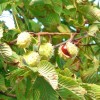How to grow chestnuts from walnuts: expert advice
Content
Preparation of planting material
So, you decided to grow a chestnut seedling on your own. The first question that always arises before you is where to get planting material? Of course, under the nearest chestnut tree: you need to plant nuts, which in autumn are abundant under each tree. And if you're lucky enough to find a less common variety that blooms pink, even better. Having conceived the germination of such a culture as chestnut from a nut at home, try to choose the best fruits, the largest, strongest and without traces of diseases. It is better to collect nuts with a stock, so that there is plenty to choose from.
Now you need to decide on the method of germination (or stratification):
- The first option is as follows: the selected chestnuts are placed directly between the roots of the parent tree, sprinkled with abundant wet sand and covered with foliage. In this form, the material is left for several months. With the arrival of spring, they are dug up, the most viable hatched nuts are selected and cultivation begins;
- the second method, how to sprout chestnuts from a nut, is somewhat more difficult, but much more effective. The collected nuts are placed in a cool place - a refrigerator or a cellar, and stored there until spring, being careful not to dry out. Such a cold regime has a positive effect on the efficiency of fruiting, stimulating the accelerated start of the regeneration mechanisms.
Video "Growing"
From the video you will learn how to grow a chestnut on your own.
How to grow yourself
It is noteworthy that the question of how to plant walnut chestnuts is often of interest to people living in city apartments. And this is quite real! A green handsome man, planted in an ordinary flower pot, feels great. To do this, you need a nut found in the fall under a tree, planted in a pot, not forgetting to water it periodically. A white sprout sprouting by spring is a sure sign that trees can be planted in separate containers.
Home cultivation also allows you to get an ornamental bonsai formed from a chestnut tree. For this, for the first few years, the plant lives as an ordinary houseplant, and then it is processed: the tree must be freed from the earthy coma, and the root system of the plant must be trimmed so that it becomes flat. The seedling prepared in this way is placed in a special soil mixture intended for bonsai plants. As soon as the plant takes root, it is transferred, along with an earthen clod, into a special container for bonsai. If you do not take patience, you may well achieve the flowering of such a chestnut-bonsai, however, this will happen no earlier than 10 years later.
Sprout care and feeding
But back to the growing process. So, the young sprout is planted in a permanent place. Now it becomes an acute task of how to grow a full-fledged tree from a small, weak sprout. Here are a few rules, following which you will surely achieve success in this difficult business:
- young seedlings growing in the area of general accessibility must be protected with pegs in order to protect them from the human factor, as well as from animals;
- you need to tie up the plant to avoid injury due to strong wind;
- young seedlings need to be watered regularly and abundantly;
- every year, in spring, the tree must be cleaned of dried or frozen branches;
- after the tree crosses the 10-year milestone, you need to prune the branches annually, forming the crown.

In addition, a young, growing tree needs feeding. The soil needs to be fertilized with compost, and every spring you can carry out regular fertilizing - water the tree with a solution consisting of 10 liters of water, 1 kg of manure and 15 g of urea.
After your pet turns 10 years old, in addition to forming a crown at will, it no longer needs any care and attention on your part: the plant is quite capable of independently existing and delighting you with its flowers.
Grow Tips Video
From the video you will learn some tips on how to grow a chestnut in the country.



